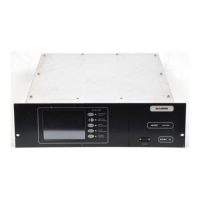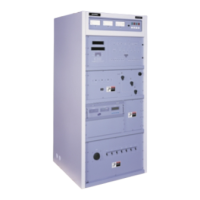6-6 888-2406-002
WARNING: Disconnect primary power prior to servicing.
Troubleshooting
6.5 Diagnostics Display Menu Tree
The most important documentation concerning the Diagnostics Display is the
“Diagnostics Display Menu Tree” located in the schematic drawing package. This
shows the complete Diagnostics Display menu structure. The menus flow from the
Main Menu at the left (on each sheet) up to 6 layers deep to the right. Due to the
number of menu screens, the drawing is divided by main menu items into 3
drawings.
• Page 1 is Status
• Page 2 is Metering and Faults
• Page 3 is Configuration and Test
It greatly simplifies the display by letting you see the entire tree with all of the
screens, guiding you to the screen you want. The only thing missing is the 6 control
buttons, HOME and BACK on the left side of the display and ABCD to the right. To
avoid confusion, every line from one screen to the next is labelled A, B, C or D
where it leaves a screen, to correspond with the keypress required on the actual
display. The function and use of the buttons is very straight forward. However, an
explanation is given in Section III, Operation, for these and all other front panel
transmitter controls.
6.6 Fault Log
The Fault Log is in the “FAULT” menu of the Diagnostics Display. To access the
Fault Log press [Fault, D]. This should bring up the screen shown in Figure 6-2.
This screen shows the latest of a possible 32 faults (the maximum number of faults
which can be stored in the log) as designated by “LOG No. 1 : N”, where N would
be the total number of faults present.Pressing A or PREV (Previous), will take you
to the next fault in the log. “Type” gives the name of the fault. “Time” gives the
elapsed time since the fault occurred, not the actual time at which it occurred.
“Status” tells you whether the fault is active or non-active.
Figure 6-2 Fault Log
